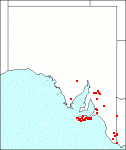Family: Poaceae
Danthonia setacea
Citation:
R. Br., Prod. Fl. Nov. Holl. 177 (1810) var. setacea.
Synonymy: Rytidosperma setaceum (R. Br.)Connor & Edgar, New Zealand J. Bot. 17:332 (1979).
Common name: Bristly (or small-flowered or mulga) wallaby-grass.
Description:
Erect densely tufted slender perennial 10-60 cm high; leaves all filiform, pubescent with tubercle-based hairs c. 0.5 mm long or glabrous, 5;-20 cm long; ligule a more or less dense ring of hairs, c. 0.5 mm long, collar hairs 1.5-2 mm long.
Panicle narrow-oblong, 3-5 cm long, ovate to lanceolate, more or less contracted and rather dense; spikelets pale-coloured or purplish, 4-10-flowered, the florets closely placed and half to two-thirds the length of the glumes, awns shortly exserted; glumes narrow, 8-14 mm long, subequal, 3-5-nerved; membranous margin broad or narrow; lemma pale-coloured, 2-3 mm long (including the hairy callus of 0.5-0.75 mm); glabrous or with a few sparse hairs on the back except for 2 whorls of hair tufts, the lower series to 1.5 mm long, the upper series to 3 mm and sometimes incomplete; lateral lobes narrow, thin, 6-10 mm long of which the greater part is a fine 4-6 mm long awn; central awn twisted 3 times or more at the base, exceeding the lateral lobes by 3-6 mm; palea-oblong-cuneate, obtuse, c. 2.5 mm long, exceeding the sinus by c. 1 mm, glabrous to sparsely hairy towards the margins; anthers c. 0.8 mm long, white or yellow; grain c. 1.2 mm long.
|
|
Distribution:
|
W. Aust.; N.S.W.; Vic.; Tas.
|
Conservation status:
native
Flowering time: usually Oct. — Jan., with 1 record for July.
|

SA Distribution Map based
on current data relating to
specimens held in the
State Herbarium of South Australia
|
Biology:
This species has been confused with D, caespirosa and the apparent difference in lemma size may not be satisfactory. The relative and overall lengths of the flat part and awn of the lateral lobe, and the length of the collar hairs are helpful in distinguishing the two species.
Uses:
Of considerable importance as a pasture grass.
Author:
Not yet available
|

